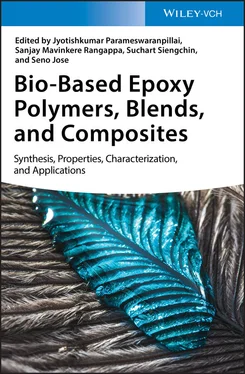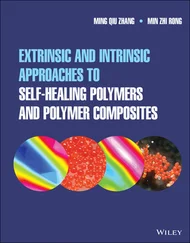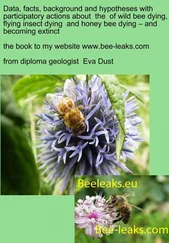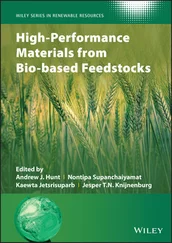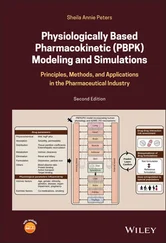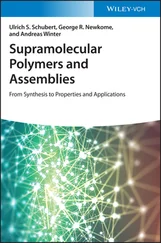a) vanillin and its naturally occurring ... Figure 1.19 Synthesis of vanillin from guaiacol. Figure 1.20 Synthesis of vanillin from guaiacol using glyoxylic acid. Figure 1.21 Synthesis of vanillin from eugenol. Figure 1.22 Schematic illustration of possible synthesis pathways (a) and (b... Figure 1.23 Synthesis of 2‐methoxyhydroquinone and its epoxy derivatives ‐ s... Figure 1.24 The
O ‐alkylation of vanillin derivatives (a), followed by the ep... Figure 1.25 Esterification of vanillic acid, followed by the
O‐ alkylat... Figure 1.26 Synthesis of glycidyl derivatives (b) based on the product of va... Figure 1.27 Synthesis of hydrovanilloin and the epoxy resin based on this va... Figure 1.28 Synthesis of 2,5‐bis(4‐hydroxy‐3‐methoxybenzylidene)cyclopentano... Figure 1.29 Synthesis of the vanillin coupling product (a) and the flame‐ret... Figure 1.30 The coupling of vanillin with pentaerythritol and synthesis of t... Figure 1.31 Schematic illustration of components of CNSL. Figure 1.32 Synthesis of NC‐514. Figure 1.33 Reactive sides of cardanol. Figure 1.34 Chemical transformation of cardanol. Figure 1.35 Synthesis of carboxyl functional cardanol and structures of the ... Figure 1.36 Chemical structure of cardanol NC‐514. Figure 1.37 Epoxy reactants: epoxidized isosorbide and polyglycidyl ether of... Figure 1.38 Chemical structure of DOPO. Figure 1.39 Synthesis of PTCP. Figure 1.40 Chemical structures of isosorbide. Figure 1.41 Schematic reaction pathway for the production of bio‐based isoso... Figure 1.42 Possible reaction pathways for the synthesis of the diepoxide de... Figure 1.43 Structure of isosorbide‐based epoxy resins. Figure 1.44 Synthetic route of diallyl isosorbide and isosorbide diglycidyl ... Figure 1.45 Synthesis of isosorbide diglycidyl ether using 4‐allyoxybenzoly ... Figure 1.46 Formation of plant terpenes. Figure 1.47 Outline of the biosynthetic pathway leading to the major monoter... Figure 1.48 Isomerization and oxidation processes for converting pinenes int... Figure 1.49 Mechanism of the cationic polymerization of β‐pinene. Figure 1.50 Chemical structures of TME, TME‐based emulsifier, and aliphatic ... Figure 1.51 Preparation of T‐PABA and T‐PABA dispersion. Figure 1.52 Synthesis of epoxy resins starting from naphthol and limonene. Figure 1.53 Synthetic route to a rosin‐based siloxane epoxy monomer (AESE).... Figure 1.54 Synthesis of C 21cycloaliphatic dicarboxylic acids and reactive ... Figure 1.55 Scheme of soybean oil functionalization with thioglycolic acid.... Figure 1.56 Synthesis of a polyamine cross‐linking agent via thiol‐ene react... Figure 1.57 Synthesis of carboxylic acid from lignin. Figure 1.58 The curing of epoxy resin using aminated lignin as a curing agen... Figure 1.59 Preparation of partially depolymerized lignin (PDL) and lignin p... Figure 1.60 Scheme of preparation cross‐linked epoxy resin. Figure 1.61 Scheme of epoxy resin by cross‐linking LSGLYPA with a mixture of... Figure 1.62 Synthesis of dihydroxyaminopropane of 2‐methoxyhydroquinone (a) ... Figure 1.63 Synthesis of the cardanol‐based novolacs. Figure 1.64 Synthesis of the isosorbide‐based cross‐linking agent. Figure 1.65 Synthesis of the isosorbide‐based cross‐linking agent via cyanoe... Figure 1.66 Synthesis of bio‐based epoxy curing agent derived from myrcene a...
2 Chapter 2 Figure 2.1 The classification of fibers [5]. Figure 2.2 Chemical structure of (a) meta ‐aramid and (b) para ‐aramid fibers.... Figure 2.3 (a) Structure of LDPE and (b) HDPE [16]. Figure 2.4 Carbon fabric [35]. Figure 2.5 The global annual required quantity for carbon composites by appl... Figure 2.6 Glass fabric [40]. Figure 2.7 GFRP production in Europe by application industry in 2018 [36].Figure 2.8 Structure of natural fibers [50].Figure 2.9 World natural fiber production: 110 million tons in 2018 [57].Figure 2.10 Flax fabric [2].Figure 2.11 The three main hybrid configurations: (a) intrayarn or fiber‐by‐...Figure 2.12 Representative chemical structures of soybean oil [100].Figure 2.13 Chemical structure of D‐isosorbide and the synthesis process of ...Figure 2.14 Chemical structure of epoxidized natural rubber [117].
3 Chapter 3Figure 3.1 PO‐based bioepoxy resin blend with DGEBA epoxy resin.Figure 3.2 Schematic representation of vegetable plant oils used for various...Figure 3.3 The life cycle of plant oil (PO)‐based polymer materials.Figure 3.4 Structure of fatty acid in plant oil‐based triglycerides.Figure 3.5 Structure of triglyceride.Figure 3.6 Representation of castor oil production [60].Figure 3.7 Schematic representations of epoxy/ECO bioepoxy blend systems.Figure 3.8 The representation of PKA‐cured epoxy/ECO blend cross‐linked netw...Figure 3.9 The representation of PKA‐cured epoxy/EMR blend cross‐linked netw...Figure 3.10 K IC, G IC, and notched impact strength of pure epoxy, bioepoxy, a...Figure 3.11 Morphology analysis of fracture surface of (a) pure epoxy, (b) b...Figure 3.12 Synthetic route of bioepoxy resin from soybean oil.Figure 3.13 Fracture toughness and impact strength of epoxy and its bioepoxy...Figure 3.14 Mechanical properties of bioepoxy blends [70].Figure 3.15 Schematic representation of the cross‐linked network of EPMO/m‐X...Figure 3.16 Applications of bioepoxy polymer in different fields.
4 Chapter 4Figure 4.1 Curing reaction of epoxides with amine [33].Figure 4.2 Curing reaction of epoxides with anhydride [51].Figure 4.3 Curing reaction of epoxides with carboxylic acid [52].Figure 4.4 DSC curing thermogram of (a) epoxy, (b) epoxy/ESO blend, and (c) ...Figure 4.5 Activation energy vs. degree of conversion plot of epoxy systems....Figure 4.6 ln( A ( f ( α )) vs. ln(1− α ) plot of virgin epoxy, epoxy/ESO,...Figure 4.7 Linear plot of Value II vs. ln( α − α 2) of epoxy, epoxy/ES...Figure 4.8 Linear plot of Value I vs. ln((1− α )/ α ) for virgin epoxy...
5 Chapter 5Figure 5.1 Rheological analysis of the isothermal curing of the polyamine gr...Figure 5.2 Rheological behaviors of polypols with different ratios between C...Figure 5.3 Rheological behaviors of polyols with different reactions.Figure 5.4 Comparing the diglycidyl ether of bisphenol A to diglycidyl adipa...Figure 5.5 Viscoelastic properties of the ECO‐based resin with an equimolar ...Figure 5.6 Isosorbide concentration effect on viscosity.Figure 5.7 Effect of SCNER content on the viscosity of DGEBA at 25...Figure 5.8 (a) Isochronal plots of complex modulus at 0.1 Hz for the epoxidi...Figure 5.9 Effect of shear rate on the melt viscosity of various ENRs in 60/...Figure 5.10 Results of (a, b) storage modulus and (c, d) loss factor of ENR‐...Figure 5.11 Viscous flow curves at 25 °C for epoxidized lignin...Figure 5.12 Evolution of the storage and loss moduli with frequency for epox...Figure 5.13 Variation of viscosity vs. time for acrylic acid (AA)/diabietyl ...Figure 5.14 Curing curves at different temperatures.Figure 5.15 Curing profile of eco‐friendly green epoxy resin at isothermal c...Figure 5.16 Comparison of storage moduli ( G ′), loss moduli ( G ″), and complex...Figure 5.17 (a) Representative storage ( G ′) and loss ( G ″) modulus curves for...Figure 5.18 G */sin vs. temperature at 10 rad/s. At 60 °C...Figure 5.19 Vacuum infusion. Results of (a) a temperature ramp and (b) isoth...Figure 5.20 Frequency dependence of (a) dynamic storage modulus, G ′ and (b) ...Figure 5.21 (a) Shear stress vs. shear rate plot, and (b) and (c) viscosity ...
6 Chapter 6Figure 6.1 Type of fillers utilized to reinforce bioepoxies.Figure 6.2 Distribution of materials utilized to reinforce bioepoxies.Figure 6.3 Distribution of natural fibers utilized to reinforce bioepoxies....Figure 6.4 Dynamic temperature ramp of a semi-crystalline, high performance ...Figure 6.5 Dynamic temperature ramp of neat PVC, an amorphous polymer. Dualc...Figure 6.6 Dynamic temperature ramp of PVC reinforced with 4 wt% bentonite....Figure 6.7 Dynamic temperature ramp of crosslinked PCL‐POSS. Film tensile mo...Figure 6.8 Dynamic temperature ramp of thermotropic liquid crystalline polym...Figure 6.9 Dynamic frequency sweeps of an acrylic coating holding isothermal...Figure 6.10 Master curve of an acrylic coating using TTS and the data of Fig...Figure 6.11 WLF shift factors a Tas a function of temperature T of an acryli...Figure 6.12 Master curve of a coating using TTS, T ref...
Читать дальше
